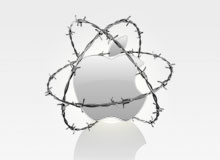“We can sit by and watch competitors steal our patented inventions, or we can do something about it.” Those words, spoken by Apple CEO Steve Jobs in early March, are only the latest in a series of verbal and legal skirmishes that are developing in the smartphone industry. Jobs’s comments, and a lawsuit filed by Apple, were directed at Taiwan-based HTC, a leading distributor of phones that are powered by Google’s Android operating system. In a statement on March 17, HTC CEO Peter Chou said his company “disagrees with Apple’s actions and will fully defend itself.”
Back in February, Motorola sued Research in Motion (RIM), maker of the BlackBerry, over patent infringements in wireless technology. And Finland-based Nokia, which boasts one of the broadest patent portfolios in the industry, sued Apple late last year over infringements on patents for its Global System for Mobile Communications (GSM), Universal Mobile Telecommunications System (UMTS) and wireless local area network (LAN) standards — only to be hit by a countersuit over patent infringement in December.
According to experts at Wharton, the flurry of patent battles playing out in U.S. federal courts and in front of the International Trade Commission — an independent government agency that determines import damages from unfair trade practices and copyright, patent and trademark infringement — is the mark of a young industry with billions of dollars at stake. Companies like Apple are looking to solidify their positions as a front runner and are willing to use their intellectual property as a weapon in their arsenal.
“Patent litigation is a tool, just like raising and lowering prices to achieve goals,” says R. Polk Wagner, a law professor at the University of Pennsylvania. And they will continue to be used, he notes. “In the case of the smartphone market, patent lawsuits are a very deliberate strategic initiative as companies jockey for position.”
Lawrence Hrebiniak, a management professor at Wharton, agrees. “These lawsuits are also about limiting competitor options. By suing, you lay down your territory, limit options and send a clear message that ‘we will sue you’ if you come too close to our technology.” Inherent in the patent strategy is becoming a so-called “first mover” in an industry and then building on that early lead to secure an ongoing advantage, he adds. “If you can use patents to become a standard, you will get more sales.”
For technology observers, patent battles are not necessarily new. “All the major [technology] players have patents, and they aren’t afraid to use them,” says Kevin Werbach, a professor of legal studies and business ethics at Wharton. “Mobile devices are a new industry emerging in the midst of this contentious patent environment.”
Many of these lawsuits are settled behind the scenes for undisclosed terms. Often, companies cross-license patents to end litigation, which could otherwise go on for years. In the smartphone industry, one of the more high-profile settlements came in 2006, when Research in Motion paid NTP, a Virginia-based patent-holding company, $612.5 million to end a long-running patent lawsuit. RIM said it decided to settle with NTP to give “certainty, calmness and comfort” to its customers.
On April 27, Microsoft and HTC signed a patent licensing pact to cover Android smartphones, the same ones Apple has sued over. Terms of the licensing deal between Microsoft and HTC weren’t disclosed. Horacio Gutierrez, deputy general counsel of intellectual property and licensing at Microsoft, said in a statement that the agreement with HTC “is an example of how industry leaders can reach commercial arrangements that address intellectual property.”
In addition to the upheaval that lengthy legal battles bring, some observers cite serious potential downsides to a strategy of aggressive patent protection, such as a chilling effect on innovation. Others note that the patent system itself needs an overhaul, and that too many companies are obtaining patents without the proper level of scrutiny.
Distract and Drain
Companies generally launch patent lawsuits for two reasons. First, mature companies that are no longer growing use patent litigation to increase their resources and cement their place in the competition. For example, in January, Eastman Kodak filed a lawsuit alleging that RIM and Apple are infringing on its patents for “technology related to a method for previewing images.” Just days before announcing the lawsuit, Kodak also announced a broad cross-licensing pact with Samsung — after having sued Samsung in 2008 over digital imaging technology in camera phones.
The second move, according to Wagner, which is typical in a newer market like smartphones, is to use patents to gain a market edge, Wagner says. Patent lawsuits distract competitors, drain capital and potentially derail product plans — all of which could be devastating to younger companies without adequate resources. Google’s Android operating system represents a significant threat to Apple’s iPhone, and some commentators believe that Apple’s lawsuit against HTC is focused on the weakest link in the Android chain. Google partner HTC, founded in 1997, is a young company and doesn’t have the resources to mount a strong countersuit, Wagner notes.
“The one advantage of suing HTC is that the company doesn’t have a big patent portfolio to strike back with” he says. “HTC is an efficient manufacturer that can move quickly. Apple is looking to take out a young upstart that can push the envelope and be more of a threat. In addition, the lawsuit is a [warning] to Google.” In other words, HTC may be collateral damage in a larger skirmish over smartphone patent dominance.
In its complaint against HTC, Apple alleges that the handset maker violated 20 patents relating to “software architectures, frameworks and implementations, including various aspects of software used to implement operating systems.” Some of Apple’s patents also cover hardware and the systems that create multi-touch functionality on touch screen phones.
Andrea Matwyshyn, a professor of legal studies and business ethics at Wharton, says that Apple’s patent portfolio can cement its position. “Litigation is a strategy established players use in addition to, and in place of, a product-focused market attack,” says Matwyshyn. “For a smaller player, the cost of litigation is significant.” According to David Hsu, a management professor at Wharton, “Apple is being aggressive [in its suit against HTC], but this is a category that is the basis of its business going forward. The iPhone powers the iPad platform and serves as a gateway into [Mac sales] as well.”
So far, the strategy seems to be paying off for Apple. Oppenheimer analyst Yair Reiner said in a research note that he found evidence that “Apple’s legal maneuvering appears to have retarded its rivals’ hot pursuit of the iPhone” because Android partners are wary of being dragged into lawsuits.
Whither Innovation?
Excessive vigilance over patents can come at a cost, experts note. “Patent litigation, and the threat of litigation, is used today both for direct financial compensation and for competitive advantage,” Werbach notes. “That doesn’t mean there are always long-term benefits. There are huge costs and risks for companies that use patents as a sword. A technology company that focuses on staying ahead through litigation may win some victories, but if it’s not able to out-innovate in the marketplace, it’s going to lose out in the long run.”
Indeed, Wagner says that new technologies can often make patent suits irrelevant. “Patent litigation is often focused on last year’s war. Apple and HTC and Nokia will be fighting over the 2009 iPhone technology when there will be 2010 and 2011 versions on the market.”
The effect on innovation will be more apparent in smaller companies, Matwyshyn adds. “A chilling effect can happen as lawsuits act as a tax on innovation for small players. If new entrants see entering a market that includes a litigation price tag they will think twice.” Meanwhile, she notes, giants like Apple will continue to innovate. Hsu agrees. “Patents are a formal channel for barriers to entry that can be quite powerful at the beginning of a life cycle,” and therefore play to the advantage of established companies.
Still, Hrebiniak says, all companies that file a bevy of patents can inadvertently tip off competitors to their new technologies. “In some cases, filing patents can facilitate imitation. Patents are public information, and filing them can allow others to look at your technology and do something different that competes.”
Reform Needed
According to Hsu, the pace of patent lawsuits tends to “slow later on in an industry’s evolution, [once] there’s a dominant design.” The larger problem, some observers say, is the way in which technology patents are handed out by the U.S. Patent and Trademark Office (USPTO).For example, many critics feel there needs to be a better emphasis on high-quality claims. “Patent protection is supposed to spur innovation,” says Kendall Whitehouse, director of new media at Wharton. “But there is a question about whether the current patent system is doing that.”
“The major problem is that it’s difficult to determine whether technology patent applications are legitimate,” Wagner notes. “The USPTO has trouble catching up and is always understaffed and resourced,” and therefore has trouble truly scrutinizing patent claims. Another problem is distinguishing between patents on business ideas, processes, software and other technologies. Couple that situation with the fact that mobile devices encompass many technologies woven together in a small package, and the potential for murky, often dubious claims multiplies exponentially.
“We need patent reform,” says Werbach. “The system is out of control in the information technology industries, especially those based on software or user interfaces. It’s hard to see how the current climate of lawsuits promotes innovation in any way commensurate with the massive direct and indirect costs. Patents exist to promote inventions, not to create new techniques to freeze the competition.”



